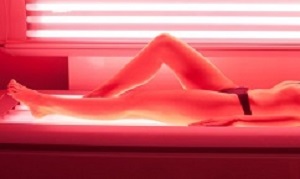 Recent reports from the European Union and the World Health Organisation that there is no safe limit for exposure to UV radiation from sunbeds, are based on an assessment of the existing scientific literature that is 'incomplete, unbalanced and uncritical', found an international meta-analysis.
Recent reports from the European Union and the World Health Organisation that there is no safe limit for exposure to UV radiation from sunbeds, are based on an assessment of the existing scientific literature that is 'incomplete, unbalanced and uncritical', found an international meta-analysis.
An international team of researchers at Saarland University, The Saarland University Hospital, VU University Medical Centre, Amsterdam, Medical University of Graz, Austria, German Cancer Research Center (DKFZ), Heidelberg University, Nuffield department of primary care health sciences, University of Oxford and the Synlab Medical Centre of Human Genetics Mannheim, coordinated by the Hamburg dermatologist Professor Jörg Reichrath, has conducted a thorough search of the scientific databases MEDLINE and ISI Web of Science for relevant studies and subjected the results to a systematic meta-analysis.
Although the team found an association of a slightly increased melanoma risk when comparing “ever” versus “never” sunbed users, they identified significant shortcomings in the scientific studies they included in their meta-analysis. Many of the earlier published results were based on observational studies with poor quality data that fail to support causation. “When you assess subgroups of study participants, it becomes apparent that other factors may well be playing a role,” explains Reichrath. “For example, solarium use could well be a marker for ‘sun worshippers’ who, by exposing themselves to excessive levels of natural solar radiation when sunbathing, tend to get sunburnt more often and therefore have a higher melanoma risk.”
In their second publication, the authors provide a critical appraisal of two reports recently published by the EU and the World Health Organisation (WHO). These reports conclude that the UV radiation in solariums is responsible for a noticeable proportion of both non-melanoma skin cancer (basal cell carcinoma, cutaneous squamous-cell carcinoma) and melanoma skin cancer. Furthermore, these reports state that a large percentage of melanomas found in patients under thirty is due to sunbed exposure. According to these reports, there is no safe limit for exposure to UV radiation from sunbeds.
Reichrath and his colleagues see things quite differently: “The opinions of the two committees behind these reports are based on an assessment of the existing scientific literature that is incomplete, unbalanced and uncritical,” says Reichrath. The conclusions from these reports are not sufficiently supported by the data.
Reichrath is very clear on this matter: “The current state of scientific knowledge in the field does not allow one to conclude that moderate solarium use results in an increased risk of malignant melanoma.”
Abstract 1
Background: There is an ongoing debate whether solarium use (indoor tanning/artificial UV) may increase the risk for primary cutaneous malignant melanoma.
Aim: A systematic literature search was conducted using MEDLINE and ISI Web of Science. Included studies were critically assessed regarding their risk of bias, and methodological shortcomings. Levels of evidence and grades of recommendation were determined according to guidelines of the Oxford Centre for Evidence-Based Medicine. Summary risk estimates and 95% confidence intervals for four different outcomes (ever exposure, exposure at younger age, high/low exposure vs. non-exposure) were derived from random-effects meta-analyses to account for possible heterogeneity across studies.
Results: Two cohort and twenty-nine case–control studies were eligible. Overall, quality of included studies was poor as a result of severe limitations, including possible recall and selection bias, and due to lack of interventional trials. Summary risk estimates suggested a weak association (odds ratio (OR)=1.19, 95% confidence interval (CI)=1.04-1.35, p=0.009) for ever-exposure to UV radiation from a solarium with melanoma risk. However, sensitivity analyses did not show an association for studies from Europe (OR=1.10; 95%CI=0.95-1.27, p=0.218), studies with low risk of bias (OR=1.15; 95%CI=0.94-1.41, p=0.179), and studies conducted after 1990 (OR 1.09; 95%CI=0.93-1.29, p=0.295). Moreover, moderate associations were found for first exposure to UV radiation from a solarium at younger age (<25 years) and high exposure (>10 sessions in lifetime) with melanoma risk. However, for all outcomes analyzed, overall study quality and resulting levels of evidence (3a–) and grades of recommendation (D) were low due to lack of interventional studies and severe limitations including unobserved or unrecorded confounding.
Conclusion: Current scientific knowledge is mainly based on observational studies with poor quality data, which report associations but do not prove causality. At present, there is no convincing evidence that moderate/responsible solarium use increases melanoma risk.
Authors
Barbara Burgard, Jakob Schöpe, Isabel Holzchuuh, Claudia Schiekofer, Sandra Reichrath, Wagenpheil Stefan, Stefan Pilz, Jose Ordenez-Mena, Wilfried März, Thomas Vogt, Jörg Reichrath
Abstract 2
The European Commission's Scientific Committee on Health, Environmental and Emerging Risks and the World Health Organization recently published reports which concluded that a large proportion of melanoma and non-melanoma skin cancer is attributable to sunbed use, and that there is no need to use sunbeds as there are no health benefits and they are not needed to achieve an optimal vitamin D level. The overall conclusion from both bodies was that there is no safe limit for UV irradiance from sunbeds. We are, however, deeply concerned that these assessments appear to be based on an incomplete, unbalanced and non-critical evaluation of the literature. Therefore, we rebut these conclusions by addressing the incomplete analysis of the adverse health effects of UV and sunbed exposure (what is ‘safe’?) and the censored representation of beneficial effects, not only but especially from vitamin D production. The stance taken by both agencies is not sufficiently supported by the data and in particular, current scientific knowledge does not support the conclusion sunbed use increases melanoma risk.
Authors
Jörg Reichrath, Pelle G Lindqvist, Frank R de Gruijl, Stefan Pilz, Samantha M Kimball, William B Grant, Michael F Holick
[link url="https://www.sciencedaily.com/releases/2018/01/180130123631.htm"]Saarland University material[/link]
[link url="http://ar.iiarjournals.org/content/38/2/1187.abstract"]Anticancer Research abstract 1[/link]
[link url="http://ar.iiarjournals.org/content/38/2/1111.abstract"]Anticancer Research abstract 2[/link]
